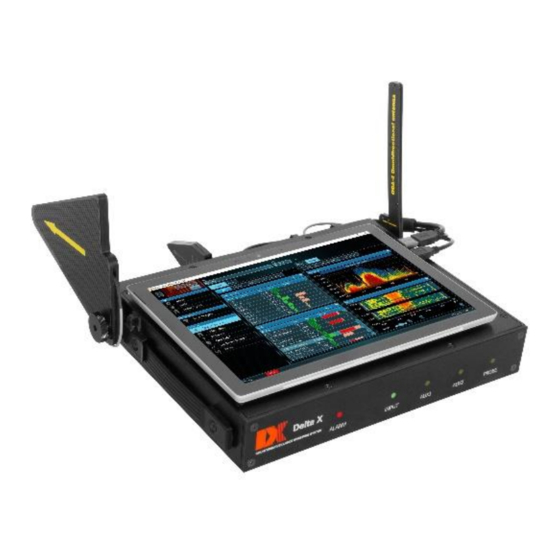
Summarization of Contents
General Description of Delta X
Introduction and Features
Overview of the Delta X system, its general features, new generation benefits, and advantages.
Features of the New Generation
Details on the portable design, magnetic holders, and expanded frequency range of the G2 models.
Key Advantages Explained
Highlights portability, large storage, touch screen compatibility, and wireless band detection.
Software Functions and Working Modes
Core Software Functions
Details on visual representation, known signals table, detector/locator, and reporting.
Working Modes Overview
Describes modes like Stop/View Log, Update Masks, RF Sweep, Guard 24/7, Probe, etc.
Specifications
General Device Specifications
Covers frequency range, update rate, reaction time, demands on laptop/tablet, and temperature.
Antenna and Probe Specifications
Details on ODA-4, MWA-6, LPDA-12 antennas and the Multifunction Probe.
Supplied Set and Initial Setup
Supplied Kit Contents
Lists all items included in the Delta X 2000/6 Real-Time and G2 models' packages.
Warnings and System Setup
Safety warnings regarding ESD and connections, plus software installation and computer setup.
System Connections and Placement
Laptop/Tablet Placement Guide
Instructions for placing and attaching laptops/tablets using magnetic holders.
USB and Antenna Connection Guide
How to connect USB cables and mount antennas for different Delta X models.
Software Operation and Settings
Running the Delta X Software
Steps to start the software, hardware detection, and initial calibration.
Interface Controls and General Settings
Overview of main controls, language, theme, and general settings like calibration and country.
Band Settings and Auto-Setup
Configuring frequency bands, auto-setup for country-specific assignments, and sensitivity.
Known Signals Management
How to manage known signals, import/export, and add new signals for better identification.
Signal Analysis Tools
Menu, Status, and Signals Table
Explains the main menu, status bar, and the Signals table content and fields.
Locator for Signal Pinpointing
How the Locator visualizes dangerous signals and aids in physical locating of transmitters.
Detector for Danger Events
Using the Detector to monitor danger levels, audio alarms, and danger history.
Spectrum Analysis Views
Details Spectrogram, Waterfall, and Persistence views for signal analysis.
Advanced Detection Modes
Update Masks Procedure
Adapting the system to the RF environment to reduce false alarms and improve sensitivity.
RF Sweep Mode Operations
Main detection mode for sweeping, including preparations, initial parameters, and detection process.
Guard 24/7 Mode
Continuous guarding for non-constant signals, with lower alarm rates and reaction times.
Car Tracker Detector Mode
Detecting GPS trackers by monitoring cellular bands and periodical exchanges.
Signal Analyzer Usage
Signal Analyzer Interface and Controls
Using the Signal Analyzer for signal inspection, demodulation, and tuning.
Analyzing Specific Signal Types
How to analyze Analog TV, Digital TV, FM radio, HD radio, and other signal types.
Data Logging and Review
Stop / View Log Functionality
Reviewing collected detection data, selecting logs and dates for analysis.
Viewing Signals and Alarms
Inspecting detected signals and alarms, correlating them with spectrum and waterfall data.
Probe Usage
Multifunction Probe Overview
Description of the probe's inputs, versions, and general operation modes.
Wire and Cable Signal Testing
Testing AC wires, low-voltage wires (telephone, Ethernet, alarm) using the probe.
Advanced Features and Reporting
Generating Detection Reports
Creating PDF reports of detected signals, alarms, and spectrum data.
Email Notifications Setup
Configuring email alerts for detected dangerous signals and report attachments.
Remote Access and Power Settings
Setting up remote access via Chrome Remote Desktop and optimizing power settings.



Need help?
Do you have a question about the G2/12 and is the answer not in the manual?
Questions and answers